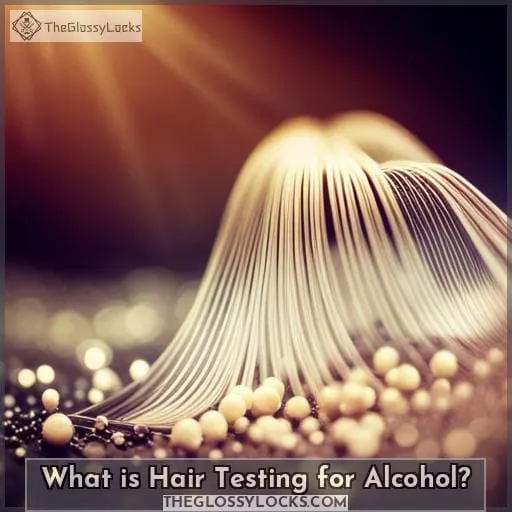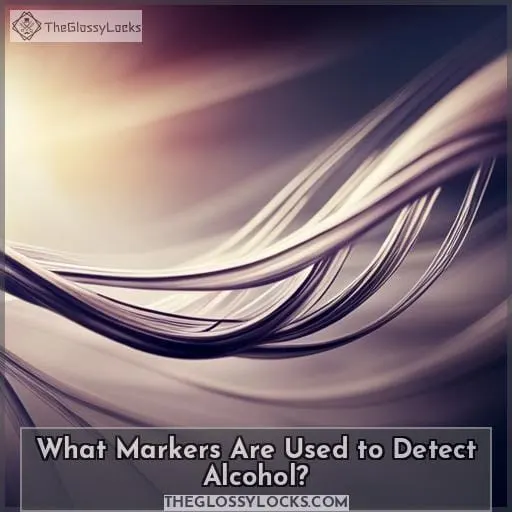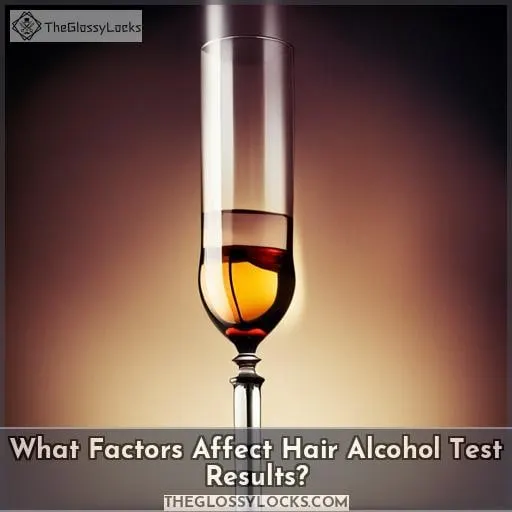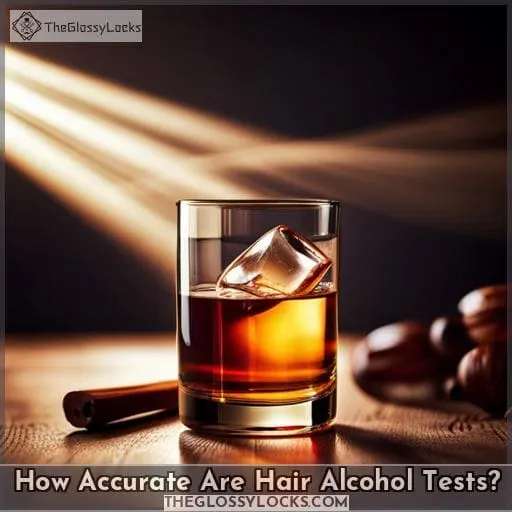This site is supported by our readers. We may earn a commission, at no cost to you, if you purchase through links.
 You’re not yourself lately. Something’s off in how you carry yourself, how you interact. I know you think no one notices, but changes in our hair can reveal more than we intend.
You’re not yourself lately. Something’s off in how you carry yourself, how you interact. I know you think no one notices, but changes in our hair can reveal more than we intend.
Don’t worry, this isn’t an intervention, just an invitation to talk. If you need help figuring things out, support is available.
A simple strand of hair can show evidence of alcohol, even if you think it’s long gone from your system. You’re more than your struggles; when you’re ready, we’ll find the way forward together.
There’s no shame in seeking understanding and relief – only hope.
Table Of Contents
- Key Takeaways
- What is Hair Testing for Alcohol?
- How Does Alcohol Get Absorbed Into Hair?
- What Markers Are Used to Detect Alcohol?
- What Factors Affect Hair Alcohol Test Results?
- How Much Hair is Needed for Testing?
- What Time Periods Can Hair Alcohol Tests Detect?
- How Accurate Are Hair Alcohol Tests?
- What Other Types of Alcohol Tests Exist?
- Who Performs Hair Alcohol Testing?
- When Should Hair Alcohol Testing Be Used?
- Conclusion
Key Takeaways
- Alcohol can enter hair through diffusion from the bloodstream to the hair follicle.
- Sweat and sebum on the scalp contain alcohol metabolites that can be absorbed into the hair shaft.
- Direct contact of hair with alcohol or alcohol-containing products can cause external contamination.
- Certain hair treatments like bleaching, perming, and using hairspray might facilitate alcohol absorption into hair.
What is Hair Testing for Alcohol?
You absorb alcohol’s ethyl glucuronide (EtG) and fatty acid ethyl esters (FAEE) markers into your hair through sweat and diffusion, where they become embedded along the entire length. Hair alcohol testing examines these ethanol biomarkers to detect patterns of alcohol consumption over time.
The more you drink, the more EtG and FAEE accumulate in your hair, providing an objective measure of your drinking habits.
Combining segmentation with EtG and FAEE improves accuracy by revealing both short- and long-term alcohol intake. Consult an experienced lab to ensure proper collection, washing, and analysis of your hair sample.
With the right procedures, hair alcohol testing can serve as a reliable indicator for abstinence monitoring, risk of alcoholism, and treatment compliance.
Choose the ideal providers to unlock your hair’s data and take control of your health.
How Does Alcohol Get Absorbed Into Hair?
Alcohol absorption into hair happens through sweat and diffusion. There are five main ways alcohol enters hair:
- As alcohol diffuses from blood vessels in the scalp into the growing hair cells.
- Through sweating, sweat glands transfer alcohol from blood to sweat onto the scalp surface.
- Alcohol vapor contacting hair can be absorbed into the shaft.
- Using hair products containing alcohol causes direct absorption.
- External contamination if hair touches alcohol.
During hair growth, alcohol markers become trapped inside the hair shaft. This provides a record of alcohol exposure over time. Hair testing examines alcohol markers like EtG and FAEE absorbed into hair through these processes.
Understanding the pathways alcohol takes into hair is key for accurate interpretation of hair alcohol results.
What Markers Are Used to Detect Alcohol?
Testing hair for alcohol use examines two key markers: ethyl glucuronide (EtG) and fatty acid ethyl esters (FAEEs). EtG is produced when the body breaks down alcohol, while FAEEs enter hair through sebaceous secretions, indicating long-term drinking habits.
The markers ethyl glucuronide (EtG) and fatty acid ethyl esters (FAEEs) are examined when testing hair for alcohol use. EtG results from alcohol metabolism in the body. FAEEs get into hair via sebum secretions and signify longstanding alcohol consumption patterns.
EtG
Ethyl glucuronide (EtG) is an alcohol metabolite absorbed into hair through sweat and diffusion, acting as a marker of alcohol consumption. EtG is produced in the liver after alcohol ingestion, entering sweat and contaminating the entire hair length.
This long-term marker survives hair treatments, with a high detection window of 3-6 months. EtG testing of multi-centimeter hair samples can reveal changes in drinking patterns, indicating abstinence versus excessive consumption.
Hair alcohol testing provides a reliable marker of alcohol usage for forensic or medical evaluation.
FAEE
Fatty acid ethyl esters (FAEEs) seep into your locks through sebaceous secretions, marking your tresses with the tale of your tippling over time. The FAEE markers your tresses absorb over months chronicle your drinking habits.
Segmental hair analysis distinguishes social drinking from alcohol abuse by measuring your hair’s FAEE concentration down its length—the more markers, the higher your intake over that time period. This test is made accurate by analyzing FAEE levels in conjunction with other alcohol markers like EtG.
What Factors Affect Hair Alcohol Test Results?
Hair treatments like bleaching, coloring, perming, and straightening can significantly impact the results of hair alcohol tests. For best accuracy, use untreated head hair collected directly from the scalp when testing for alcohol consumption.
Hair Treatments
You’re good to go as long as you provide an updated product list before they collect your locks.
- Bleaching
- Straightening
- Perming
These common hair treatments can compromise results. Submit a list of all hair products used since your last cut to the testing lab. They’ll check for possible interference with alcohol absorption markers like EtG and FAEE.
Hair Sample Type
The hair on your head alone can reveal the full story of your alcohol consumption, my friend. Bald? Chest hair may be your only option, though it is not ideal. The steady growth of head hair allows tests to easily trace back months.
Other areas grow at varying rates, muddling results. Plus some spots see more contamination from product use. For the complete alcohol history, head hair is best. Care for your locks so your story stays clear as day.
How Much Hair is Needed for Testing?
The amount of hair required for alcohol testing depends on the length of the time period being analyzed. Typically, 200 strands of head hair are needed to provide an accurate result. This allows the lab to segment the hair sample into the standard 3 or 6 cm lengths that represent 3 or 6 months of growth.
More hair may be needed for individuals with fine or sparse hair. The preferred hair sample is head hair since it has a predictable growth rate influenced by factors like genetics and age, which can affect the hair growth cycle. The preferred hair sample is head hair since it has a predictable growth rate of approximately 1 cm per month. While hair can be collected from other body sites, head hair provides the most reliable history of alcohol consumption.
Less hair’s needed for alternative tests like blood or urine tests, but hair testing allows examination of longer periods.
- 200 strands of head hair’re recommended
- More hair’s needed for fine or sparse hair
- Head hair’s preferred due to predictable growth
- Allows segmentation into 3 or 6 cm lengths
- Less hair’s needed for blood or urine tests
What Time Periods Can Hair Alcohol Tests Detect?
Recently, meth rodents have proved hair can show six days of helium use.
Alcohol’s journey through your body leaves traces in your hair that tell a hidden tale. Like reading the rings of a tree, hair offers a timeline of your alcohol exposure. Testing 3 cm of hair reveals patterns from the past 3 months with high accuracy.
The sensitivity and specificity of alcohol markers in hair detect chronic excessive drinking over this period. Combining head and body hair samples enhances the biomarkers and etg markers that distinguish social drinking from alcohol abuse.
Hair alcohol tests give a trustworthy account of your alcohol consumption history. Though unable to pinpoint exact drink dates, the results provide an honest sketch of the past months.
How Accurate Are Hair Alcohol Tests?
You’d be confident the six-month results were reliable as long as your hair wasn’t chemically treated.
- EtG and FAEE markers in hair.
- Changes in alcohol consumption patterns through EtG.
- Long-term habitual drinking patterns through FAEE.
Combining hair testing with self-reporting and other methods further enhances accuracy. Though reliable overall, factors like hair treatments and sample collection can impact results. Ensure proper protocols are followed and consider your hair care regimen when interpreting findings.
The hair alcohol test excels at indicating alcohol abuse, abstinence or social drinking in various populations when applied correctly.
What Other Types of Alcohol Tests Exist?
For you’re judged, there are other blood or urine tests if hair ain’t an option, buddy. Blood alcohol tests measure BAC and reveal recent drinking, but can’t detect over days.
| Test | Detection Period |
|---|---|
| Hair | Up to 6 months |
| Blood | Past 12 hours |
| Breath | Up to 8 hours |
Hair alcohol best shows habits, while blood and breathalyzers indicate acute intoxication. But blood’s useful revealing alcohol markers if no hair’s available. Choose the fittin’ test to reveal truth, not just label one a drunk.
Still, results have legal implications, so take care and avoid excess elixir, amigos.
Who Performs Hair Alcohol Testing?
Hair alcohol testing is performed by skilled professionals. Toxicologists like me examine your hair strands. We rely on qualified laboratories and technicians to process samples. These experts follow strict protocols from the Society of Hair Testing to ensure accurate, reproducible results.
Clinicians such as addiction medicine specialists may order hair testing and interpret your results along with your history. Counselors use these tests to support treatment plans. As a scientist developing improved hair alcohol markers, my work requires analyzing hair composition and alcohol metabolites.
Overall, the most qualified toxicologists, labs, clinicians and researchers conduct hair alcohol testing. Their careful work reveals your alcohol exposure, guiding treatment and legal decisions.
When Should Hair Alcohol Testing Be Used?
When should hair alcohol testing be used?
Hair alcohol testing offers objective insight when legal implications loom, whether from workplace infractions, court cases, or parental concerns over a child’s welfare. While urine and blood samples show recent drinking, EtG testing of 3- to 6-month hair segments gives a long view of abstinence claims or changes in problematic drinking.
When patient history’s unreliable or the situation’s critical, hair alcohol testing gives an accurate timeline to inform rehab programs, child custody decisions, and other critical cases. Combining hair analysis with traditional CDT blood tests ensures comprehensive evaluation of long-term habits.
By targeting ethanol metabolites absorbed into the hair shaft, this non-invasive technique provides definitive evidence of drinking patterns over long periods.
Conclusion
Let’s be real for a sec. You thought those bottles under the bathroom sink were your dirty secret. That spraying extra hairspray might mask the smell of a three-martini lunch. That no one would find out about your liquid lunches or late nights if you just tossed some mints back.
Well, think again. Every sip gets soaked up right into every hair strand. The EtG and FAEE don’t lie. They’ll snitch faster than a Vegas waitress cuts you off after one too many gin and tonics.
So listen up, bud. That ‘hair of the dog’ may buy you time, but it can’t hide the truth forever. Everything you drink ends up in your hair, and we’ll know all about it. Might be time to switch to mocktails at happy hour.
Take it from me – you can’t fool your follicles.













